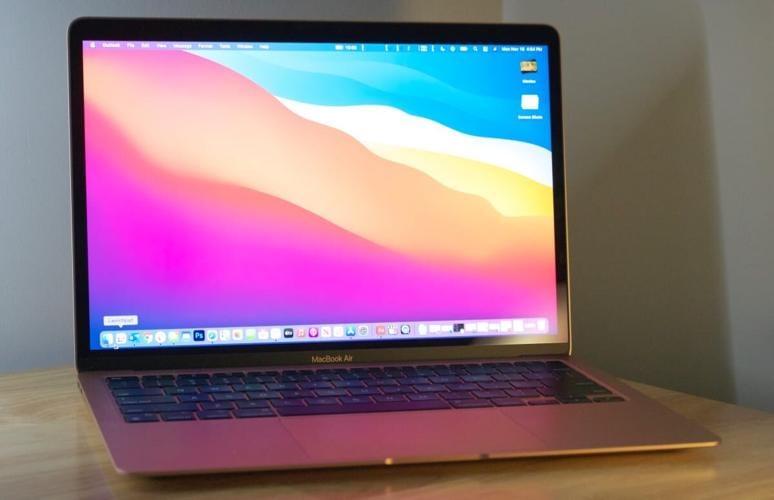
Amazon.com: Privacy Screen Macbook Air 13 Inch(2018-2021, M1)/Macbook Pro 13 In(2016-2022, M1, M2), Magnetic Removable Anti Blue Light Glare Filter Privacy Screen Protector With Camera Cover for Mac 13In Laptop : Electronics

Amazon.com: Apple MacBook Air MC965LL/A - C Intel Core i5-2557M 2nd Gen X2 1.7GHz 4GB,Silver(Scratch and Dent) (Renewed) : Electronics

Amazon.com: IBENZER Compatible with 2022 2021 2020 MacBook Air 13 inch case M1 A2337 A2179 A1932, Plastic Hard Shell Case for Mac Air 13 Retina Display with Touch ID, Crystal Clear, MMA-T13CYCL : Electronics

Amazon.com: Mid 2019 Apple MacBook Air with 1.6GHz Intel Core i5 (13 inch, 8GB RAM, 256GB) Silver (Renewed) : Electronics

Amazon.com: F FORITO 2 PACK Anti Glare Laptop Screen Protector Compatible with 2018-2020 MacBook Air 13 with Touch ID Version A1932 A2179 A2337 M1, Anti-scratch & Anti-fingerprint (Matte) Screen Filter : Electronics

Amazon.com: Apple 2022 MacBook Air Laptop with M2 chip: 13.6-inch Liquid Retina Display, 8GB RAM, 256GB SSD Storage, Backlit Keyboard, 1080p FaceTime HD Camera. Works with iPhone and iPad; Midnight : Electronics

Amazon.com: Apple MacBook Pro 13.3" with Retina Display, M2 Chip with 8-Core CPU and 10-Core GPU, 16GB Memory, 256GB SSD, Silver, Mid 2022 : Electronics

Amazon.com: CaseBuy Premium Keyboard Cover for MacBook Air M2 13.6 A2681, MacBook Pro 14 Inch & MacBook Pro 16 inch 2023 2022 2021 A2442 A2779 A2485 A2780 M2 M1 Pro/Max US Keyboard Protector -Clear : Electronics

Amazon.com: Purgo Mini USB C Hub Adapter Dongle for MacBook Air 2022-2018 and MacBook Pro 13 M2 2022-2016, MacBook Air USB Adapter with 4K HDMI, 100W PD, 40Gbps TB3 5K@60Hz, USB-C and

MacBook Air Guide: The Ultimate Guide for MacBook Air & macOS: Rudderham, Tom: 9781791974527: Amazon.com: Books

Amazon.com: Apple Laptop MacBook Air MD628LL/A Intel Core i5 1.70 GHz 4 GB Memory 64 GB SSD 13.3in Display (Renewed) : Electronics

Amazon.com: Early-2015 Apple MacBook Air with 1.6GHz Intel i5 (11-Inch, 8GB, 128GB) (Renewed) : Electronics

Amazon.com: Apple MacBook Air MD711LL/A 11.6-inch Laptop - Intel Core i5 1.3GHz - 4GB RAM - 128GB SSD (Renewed) : Electronics

Amazon.com: Apple MacBook Air 11.6-Inch Laptop Core i7 2.0GHz (MD845-BTO/CTO) 8GB Memory, 256GB Solid State Drive, MacOS 10.12 Sierra (Renewed) : Electronics

Amazon.com: Keyboard Cover for MacBook Air 13 inch 2022 2021 2020 A2337 M1 A2179, MacBook Air M1 Keyboard Skin 13.3, US Layout Protective TPU Keyboard Skin : Electronics

Amazon.com: 2019 Apple MacBook Air with 1.6GHz Intel Core i5 (13-inch, 8GB RAM, 128GB SSD Storage) Gold (Renewed) : Electronics

Amazon.com: Apple 2020 MacBook Air Laptop M1 Chip, 13" Retina Display, 8GB RAM, 256GB SSD Storage, Backlit Keyboard, FaceTime HD Camera, Touch ID. Works with iPhone/iPad; Gold : Electronics

Amazon.com: Apple 13in MacBook Air, 2.2GHz Intel Core i7 Dual Core Processor, 8GB RAM, 512GB SSD, Mac OS, Silver (Renewed) : Electronics

Amazon.com: Apple 2020 MacBook Air Laptop M1 Chip, 13" Retina Display, 8GB RAM, 256GB SSD Storage, Backlit Keyboard, FaceTime HD Camera, Touch ID. Works with iPhone/iPad; Silver : Electronics

Amazon.com: Apple 2020 MacBook Air Laptop M1 Chip, 13" Retina Display, 8GB RAM, 256GB SSD Storage, Backlit Keyboard, FaceTime HD Camera, Touch ID. Works with iPhone/iPad; Gold : Electronics






